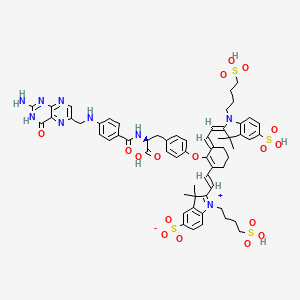



1. Cytalux
2. Otl-0038
3. Otl-38
4. Otl0038
5. Otl38
1. Otl-38
2. Otl 38
3. Otl 0038
4. Otl38
5. Otl0038
6. Otl-0038
7. Pafolacianine [usan]
8. F7bd3z4x8l
9. 1628423-76-6
10. Unii-f7bd3z4x8l
11. Chembl4297412
12. Who 11569
13. Db15413
| Molecular Weight | 1326.5 g/mol |
|---|---|
| Molecular Formula | C61H67N9O17S4 |
| XLogP3 | 4 |
| Hydrogen Bond Donor Count | 8 |
| Hydrogen Bond Acceptor Count | 22 |
| Rotatable Bond Count | 24 |
| Exact Mass | 1325.35377640 g/mol |
| Monoisotopic Mass | 1325.35377640 g/mol |
| Topological Polar Surface Area | 441 Ų |
| Heavy Atom Count | 91 |
| Formal Charge | 0 |
| Complexity | 3330 |
| Isotope Atom Count | 0 |
| Defined Atom Stereocenter Count | 1 |
| Undefined Atom Stereocenter Count | 0 |
| Defined Bond Stereocenter Count | 3 |
| Undefined Bond Stereocenter Count | 0 |
| Covalently Bonded Unit Count | 1 |
Pafolacianine is an optical imaging agent indicated in adult patients with ovarian cancer as an adjunct for intraoperative identification of malignant lesions.
Tumor to background ratios changed with different mass doses studied. High tumor to background ratio was observed with 0.025 mg/kg dose. Pafolacianine exposure-response relationships and the time course of pharmacodynamic responses are unknown.
Molecular Probes
A group of atoms or molecules attached to other molecules or cellular structures and used in studying the properties of these molecules and structures. Radioactive DNA or RNA sequences are used in MOLECULAR GENETICS to detect the presence of a complementary sequence by NUCLEIC ACID HYBRIDIZATION. (See all compounds classified as Molecular Probes.)
Absorption
The mean Cmax of pafolacianine was 59.1 5.94 ng/mL and AUCinf was 63.6 12.6 ng x hr/mL.
Route of Elimination
Following a single intravenous infusion of radiolabeled pafolacianine sodium, approximately 35% of the dose was recovered in urine (19.1%) and in feces (15.8%) after approximately 3-5 weeks.
Volume of Distribution
The mean volume of distribution (Vz) is 17.1 5.99 L, indicating distribution into tissues. During intraoperative molecular imaging for surgically resectable pulmonary adenocarcinoma, pafolacianine accumulated in nearly 70% of squamous cell carcinomas.
Clearance
The mean plasma clearance is 28.6 4.97 L/hr.
The metabolism of pafolacianine is unknown; however, pafolacianine is not metabolized by cytochrome P450 (CYP) enzymes.
The elimination half-life of pafolacianine is 0.44 0.23 hours.
Pafolacianine is consists of folic acid linked by its -carboxyl and a short spacer to an indocyanine green-related near-infrared dye called SO456. It is used for intraoperative fluorescence for tumour identification and surgical resection. It targets the folate receptor alpha (FR), which is often overexpressed in various cancers including ovarian cancer. Pafolacianine binds to FR-expressing cancer cells with an affinity of ~1 nM and is internalized via receptor-mediated endocytosis to be concentrated in FR-positive cancer tissues. Pafolacianine absorbs light and in the near-infrared (NIR) region within a range of 760 nm to 785 nm with a peak absorption of 776 nm and, upon excitation, emits fluorescence within a range of 790 nm to 815 nm with a peak emission of 796 nm.